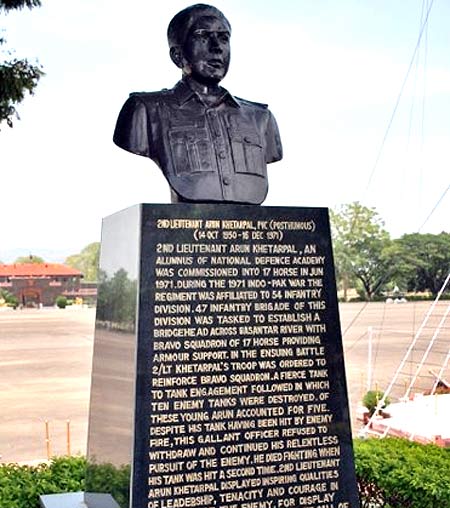
We fought as a well knit armed force, blazed our own trail and wrote a golden chapter of the 1971 war, remembers Lieutenant General B T Pandit (retd), who was awarded a Vir Chakra in the war.
Forty years ago, on December 3, open hostilities began between India and Pakistan leading to what is popularly known as the 'Bangladesh War.' It was a historic occasion for India in many ways. The war ended in a resounding victory for us on December 17, 1971. Naturally, thinking back about it has triggered all old memories in a retired soldier like me.
Then a lieutenant colonel, I was the commanding officer of the 9 Engineer Regiment of the Madras Sappers. We were part of the famous 54 Infantry Division commanded by then Major General W A G Pinto. Together we wrote a golden chapter of this war.
We had launched an offensive into Pakistan's West Punjab Shakargarh sector from Samba near Jammu. From December 3 to December 17, we fought as a well knit armed force; blazed our own trail, breached three minefields of unprecedented depths, and forced the enemy to react and commit his theatre reserves at the place and time of our choosing.
This thrust into the Pakistani heartland culminated in the epic Battle of Basantar from December 15 to 17, where we decimated the opposition by knocking out one infantry and one armoured brigade.
As a consequence of this, the Pakistan high command had to concede defeat and agree to a ceasefire in the western theatre from 2000 hours on December 17. This was already in force in the Eastern Theatre on December 14.
Our success in the Battle of Basantar has been corroborated by the Pakistani side in an article in the Pakistan Army Journal by General Jehangir Karamat, who commanded an armoured regiment in this battle and later rose to be the army chief of Pakistan.
Please ..

Even after 40 years, I remember vividly every single moment of that exciting fortnight even to the instant when at 2000 hours on December 17, an eerie silence descended on the pitch dark battlefield which till then was reverberating and resounding with battlefield noises (machinegun/tank fire, artillery shelling, hostile aircraft sorties etc and battlefield illumination).
There were many a thrilling moment for me personally. I can't ever forget the exhilarating feeling when at about 2000 hours on D Day, I stepped on Pakistan soil across the International Border.
Later, we put up a signboard stipulating that no passport was required.
Similarly, when we successfully breached first of the three minefields laid by the enemy hoping to bring our offensive to a grinding halt; when in the final battle at a critical stage two of our infantry battalions in the Bridgehead (16 Madras, 3 Grenadiers) were under severe pressure due to counter-attacks by the enemy, we could induct our own armour as reinforcement through the safe lane breached by us across a 1,300 metre deep minefield.
The blazing taillights of the tanks of the leading squadron crossing the minefield made an unforgettable picture. The list can go on.
Equally, there were many tense and sad moments:
When my jeep was strafed by a Pakistani fighter aircraft leading to the death of my driver and radio operator, yet providentially leaving me without a scratch;
When as the commanding officer I had to light the pyres of many of my comrades including four officers;
When I saw the heartrending sight of a gallant infantry battalion having taken nearly 100 casualties (dead/wounded) including the commanding officer who was my friend and still the brave battalion was grimly holding on;
When as a poignant gesture we handed over some 80 dead bodies of Pakistani casualties including the gallant commanding officer of 35 Frontier Force.
Please ..

I also had the privilege to be around to watch numerous acts of gallantry and outstanding heroic deeds such as young Lieutenant Arun Khetrapal and Major Hoshiar Singh. Both were awarded the highest gallantry decoration, the Param Vir Chakra, the former as a posthumous award.
We in the 9 Engineer Regiment had our own share of gallantry awards. The regiment was awarded battle honour Basantar and theatre honour Punjab. Our gallantry awards included one Mahavir Chakra, 3 Vir Chakras (including my own), 4 Sena Medals and 3 M-in-D.
In the process we had to pay a heavy price of nearly 20 casualties (all types) including 7 officers.
I can't help but make a mention of the invaluable supportive role played by our families. My wife, then barely in her early thirties, not only took care of the regimental families (some 120 ladies and their children) back at our peace station Lucknow, but also kept on encouraging and exhorting me to do my duty by 'Our Regiment and the Thambis.'
Her letters to this effect are as precious to me as the citation for my Vir Chakra.
After the war when I visited the family in mid January 1972, I was honoured by Lieutenant General P S Bhagat, Victoria Cross, who was the army commander at Lucknow. He, very succinctly summarised our feelings. He said, "BT you and me are lucky soldiers, only lucky soldiers see war and luckier ones get challenging tasks, succeed, survive and their contribution is recognised by the service and the nation." How very true!!
For me it was a singular honour to command the gallant Indian jawans in my nearly four decades of service, in war as well as No-War-No Peace along the Line of Control in Jammu and Kashmir, Nagaland and Punjab.